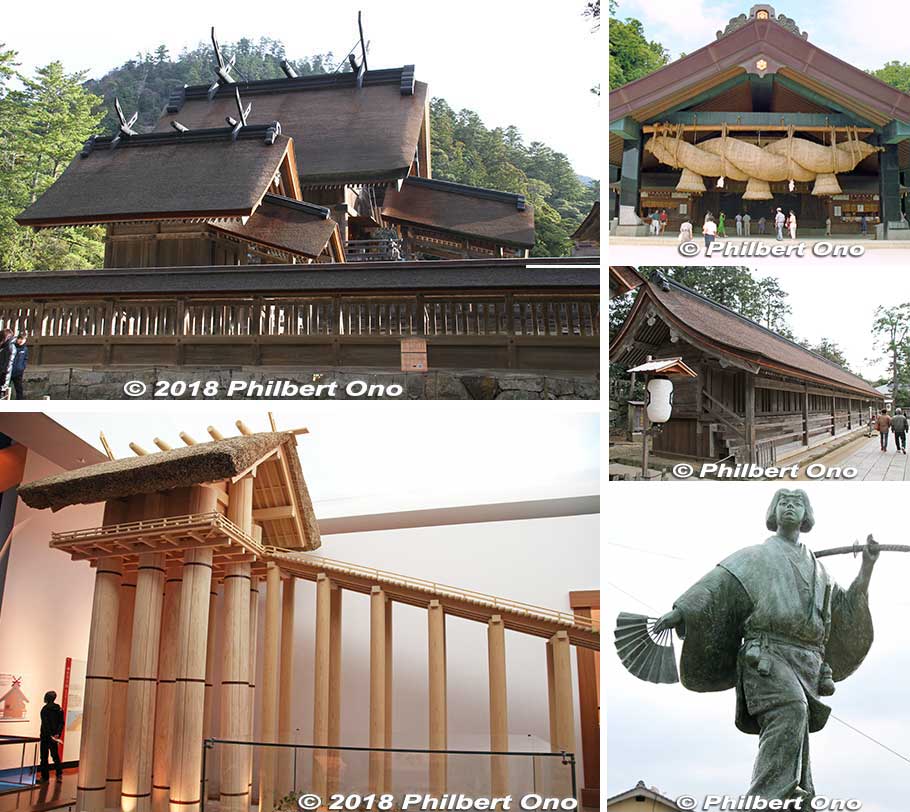
If you want to avoid tourist crowds, the San’in Region (Tottori, Shimane, Yamaguchi Prefectures) facing the Sea of Japan is the perfect answer. Lots of sights and relatively few tourists on Japan’s “Mountain Shadow” side (San’in 山陰). You can take it easy here. Makes traveling less stressful.
Being out of the way from major cities, this region has worked hard to promote tourism. Then the pandemic hit. Many museums, tourist sights, etc., were closed, but after implementing safety measures, most have reopened. Of course, wearing a mask, social distancing, using hand sanitizer, etc., are being required like everywhere else in Japan. Perhaps due to its low population and remoteness, the San’in Region is seeing much fewer Covid cases compared to the rest of Japan. (Shimane’s population is 666,970 and Tottori 550,527 as of April 2021.)
Izumo Taisha is one of the San’in Region’s top sights and one of Japan’s Top Three important Shinto shrines (besides Ise Jingu in Mie Prefecture and Atsuta Shrine in Nagoya, Aichi). I once visited on New Year’s Day (2018) which is the busiest day of the year for major shrines. But the crowds at Izumo Taisha were still relatively sparse compared to other major shrines. I was able to reach the main shrine with hardly any waiting. There was none of the slow-moving, stop-and-go New Year’s congestion typical at Meiji Shrine (Tokyo), Ise Jingu, Atsuta Shrine, Fushimi Inari Taisha (Kyoto), or Sumiyoshi Taisha (Osaka).
Izumo Taisha is in a nice wooded area. Unlike Ise Jingu whose main buildings are mostly hidden from view, Izumo Taisha is much more visible even with the surrounding fence (upper left photo). The largest building in the upper left photo is the Honden where the god resides. The Honden was built in 1744 and is a National Treasure. This unique shrine architecture is called “Taisha-zukuri” (大社造). The V-shaped roof ornaments (chigi) look slightly different from other shrine architectural styles. Another iconic building is the Kaguraden Hall (for sacred dances) famous for its gigantic straw rope (upper right photo).
One god Izumo Taisha worships is Okuni-nushi (大国主大神), the Shinto god of marriage. In autumn, Japan’s millions of gods gather here at Izumo Taisha to hold meetings to decide the marriage partners and good fortune of humans. Shrine priests go to the nearby beach to welcome the arriving gods. The shrine even has lodging (longhouse shrines in the middle right photo) for these gods during the festival called “Kami-ari-zuki” (Month of the Visiting Gods 神在月).
Many other interesting things are associated with Izumo Taisha such as a shrine maiden named Izumo no Okuni who founded kabuki when she entertained in Kyoto to raise funds for the shrine in the 17th century. Yes, it was started by a woman even though kabuki now forbids female actors. There’s a statue of her near the shrine (lower right photo).
The shrine grounds also has the Shimane Museum of Ancient Izumo (島根県立古代出雲歴史博物館). A must-see. One great mystery about Izumo Taisha is what it looked like in the early centuries. The museum has scale models of what the Honden main shrine may have looked like. Lower left photo shows one impressive scale model depicting the Honden in the 10th century on very high wooden pillars connected by a long, sloping stairway.
There is a general consensus that the Honden was originally built high in the sky on tall pillars to be closer to the gods. Evidence of massive wooden pillars have been recently excavated at the shrine. The question is, how did they build it and how high was it? For humans though, a lofty shrine wasn’t so practical. It eventually went back down to Earth (upper left photo). ![]()
![]() Closest train station is JR Izumo-shi. Then a 25-min. bus ride to Izumo Taisha and short walk to the shrine. From Tokyo by train, take the shinkansen to Okayama Station, then transfer to the Tokkyu Yakumo express train for Izumo-shi Station. It will take at least 7 hours. Overnight sleeper train “Sunrise Izumo” also available. Closest airport is Izumo (Enmusubi) Airport. (80-min. flight from Haneda, Tokyo.). There’s also Izumotaisha-Mae Station on the local Ichibata Railway from Matsue.
Closest train station is JR Izumo-shi. Then a 25-min. bus ride to Izumo Taisha and short walk to the shrine. From Tokyo by train, take the shinkansen to Okayama Station, then transfer to the Tokkyu Yakumo express train for Izumo-shi Station. It will take at least 7 hours. Overnight sleeper train “Sunrise Izumo” also available. Closest airport is Izumo (Enmusubi) Airport. (80-min. flight from Haneda, Tokyo.). There’s also Izumotaisha-Mae Station on the local Ichibata Railway from Matsue.
Izumo Taisha: https://izumooyashiro.or.jp/
Museum: https://www.izm.ed.jp/english/